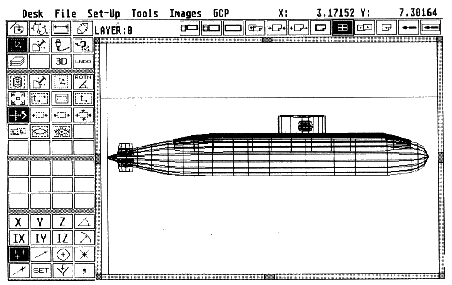WORLDS
CAD-3D-to-DynaCADD Converter
PROGRAM BY DAVID FLETCHER
ARTICLE BY ANDREW REESE, START EDITOR
With the CAD-3D-to-DynaCADD converter on this issue's START disk, you can have the best of both worlds: create your 3D objects in CAD-3D or Cyber Sculpt and then convert them to DynaCADD format to take advantage of its wealth of features and plotter support. The converter runs in both color and monochrome.
Design in Cyber Studio, plot in DynaCADD. File CADDYNA.ARC on your START disk.
If you're like many CADD professionals, you've probably fooled around with CAD-3D 2.0 and Cyber Sculpt from Antic Software. You've been impressed with their ease of use and power, but have wished that they had more CADD features, such as dimensioning, text capability or plotter support.
Then along came DynaCADD and you took to it immediately for its 2D and 3D capabilities, easy interface and features unavailable in any program (and some unavailable on any other microcomputer). But you probably also found that, as powerful as DynaCADD is, its 3D object creation and manipulation tools are just not as easy and intuitive as CAD-3D's.
The solution? On this issues START disk is the file CADDYNA.ARC. It's an archived file containing CONVERT.TOS, a file conversion utility written by David Fletcher; DynaCADD's chief programmer, and included on the START disk through the courtesy of Nathan Potechin and Oren Asher of ISD Marketing. The CAD-3D-to-DynaCADD converter may be distributed freely.

This submarine was created
in Cyber Sculpt, converted to an ASCII text
file in CAD-3D 2.0 and
then converted using CONVERT.TOS to DynaCADD
format.
A Simple Operation
To convert CAD-3D objects to DynaCADD format, you must first copy CADDYNA.ARC
to a blank, formatted disk and un-ARC it following the Disk Instructions
elsewhere in this issue. When you've finished, you will have the program
CONVERT.TOS.
In order to convert a CAD-3D object to DynaCADD, you must first load
the CAD-3D file into CAD-3D 2.0 and use the Object List option on the File
menu to generate an ASCII disk file. (You don't have to have CYBSMASH.ACC
installed to do this.) When the dialog box appears asking you to "Print
to which device?", click on the Disk button. When the file selector box
appears, enter the path and filename you wish and then click on OK. If
you have created your object in Cyber Sculpt, you will need to save it
as a .3D2 file and then load it into CAD-3D 2.0 to do this preliminary
conversion.
| ** CAD 3D 2.0 to DynaCADD DEF 2.0
** Copyright (c) April 1989 ** by David P Fletcher ** All Rights Reserved CAD 3D file to be converted : C:\CADSTUFF.ETC\SUB.TXT
Remove extra lines ( Y/N ) ? Conversion started... Object name: SECTION
Object name: sail1
|
.DEF file that you can load into DynaCADD. As it runs, it will keep you apprised of its progress.
To run CONVERT.TOS, double-click on it from the Desktop. Then type in the path and name of the ASCII object file you wish to convert and press [Return]. You will then be asked to enter the name you want for the .DEF file and whether you want to remove duplicate lines. Type in a Y for yes or N for no and the converter will load in the file you specified and convert it. You will see several status messages as the program runs, as shown in the accompanying illustration. If you want to pause the program, you may do so by pressing [Control]-[S]; press [Control]-[Q] to resume. To cancel the conversion, press [Control]-[C].
Note: Be sure that you have enough disk space for these conversions. For example, the 3D2 submarine file only required 17,822 bytes, but the ASCII .TXT file took 79,775 and the .DEF file took 134,012 bytes!
ISD's David Fletcher is the head programmer for DynaCADD.
PRODUCTS MENTIONED
DynaCADD version 1.56, $995. SD Marketing, 2651 John Street,
Unit 3, Markham Industrial Park, Ontario, Canada L3R 6G4, (416) 479-1880.
CIRCLE 164 ON READER SERVICE CARD
Cyber Studio, Including CAD-3D 2.0, $89.95. Antic Software, 544
Second Street, San Francisco, CA 94107, (800) 234-7001.
CIRCLE 184 ON READER SERVICE CARD